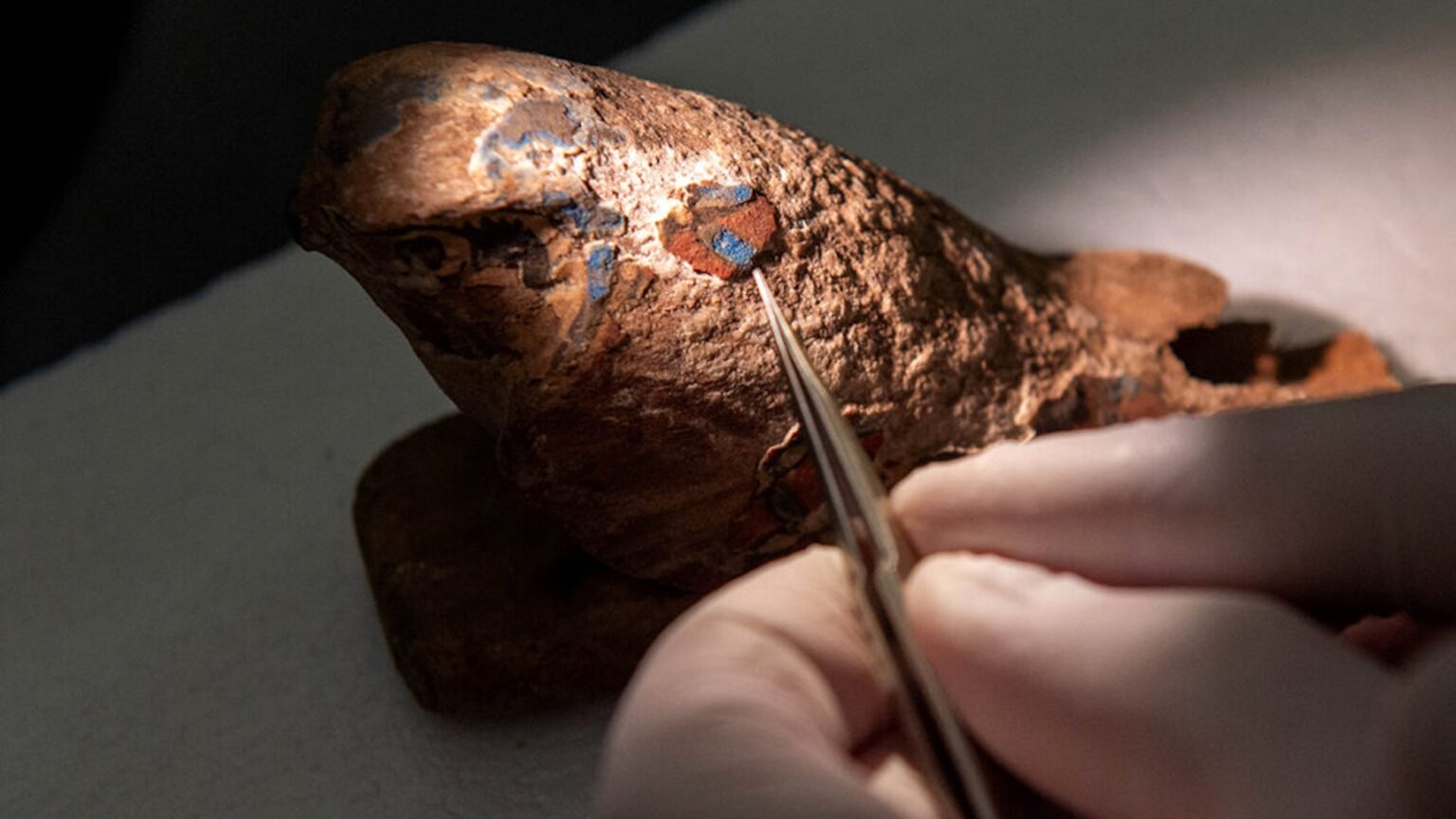Unlocking the Secrets of Egypt’s Ancient Pigments: A Modern Reproduction of Egyptian Blue
!Ancient Egyptian artifact with flecks of dye being examined
Researchers analyze a wooden falcon artifact to uncover the secrets of ancient Egyptian dyeing techniques. Credit: Matt Unger / Carnegie Museum of Natural History
The Enigma of Egypt’s Oldest Synthetic Pigment
For centuries, scholars have been captivated by Egyptian blue, the world’s earliest known synthetic pigment, dating back approximately 5,000 years. Unlike a single, uniform hue, this ancient dye spanned a spectrum-from deep, vibrant blues to muted greens and grays-highlighting its complex composition. Originating during Egypt’s Fourth Dynasty (roughly 2613-2494 BCE), artisans crafted Egyptian blue using a mixture primarily composed of calcium, copper, and silica compounds. This pigment’s unique properties made it highly desirable, and it was later adopted by the Romans as a cost-effective alternative to precious stones like lapis lazuli and turquoise.
The Lost Recipes and Their Modern Significance
Despite its historical importance, the precise recipes and manufacturing techniques for Egyptian blue have been lost to time, especially by the Renaissance period. This gap in knowledge has posed significant challenges for conservationists aiming to preserve ancient artifacts. Moreover, Egyptian blue’s distinctive physical and optical properties-such as its ability to emit near-infrared light invisible to the naked eye-make it a promising candidate for cutting-edge applications today. These include anti-counterfeiting measures, fingerprint detection, and even potential use in high-temperature superconductors.
Recreating the Ancient Art of Pigment Production
In a groundbreaking study, researchers from Washington State University (WSU), in collaboration with the Smithsonian Conservation Institute and the Carnegie Museum of Natural History, embarked on a mission to replicate Egyptian blue with unprecedented accuracy. Their goal was not only to understand its composition but also to produce authentic samples that could aid in the restoration of ancient relics.
Initially, the team approached the project with a casual curiosity, motivated by a request to demonstrate pigment creation for a museum exhibit. However, their interest quickly deepened as they recognized the broader implications of their work. “What started as a simple demonstration evolved into a comprehensive investigation into the material’s properties,” explained John McCloy, lead author and materials engineer at WSU.
Methodology: From Ancient Techniques to Modern Science
The team assembled a panel of experts, including mineralogists and Egyptologists, to identify potential raw materials-such as calcium carbonate, copper compounds, silicon dioxide, and sodium carbonate. They experimented with varying the proportions of these ingredients before subjecting the mixtures to high-temperature heating, reaching approximately 1,832°F (around 1,000°C)-a temperature easily attainable by ancient Egyptian artisans.
The heated mixtures were then cooled at different rates, with the team meticulously analyzing each sample using advanced techniques like X-ray diffraction, electron beam microanalysis, and nano-computed tomography. These analyses allowed them to compare their recreated pigments with authentic ancient artifacts, including a piece of cartonnage-a type of papier-mâché used in funerary masks.
Key Findings: Variations in Technique and Color
One of the most striking discoveries was how subtle differences in the cooling process significantly affected the final hue. Slower cooling resulted in deeper, more saturated blue shades, while rapid cooling produced lighter gray-green tones. Interestingly, all the variants contained cuprorivaite-the naturally occurring mineral that imparts the characteristic blue color-encased within a matrix of silicate particles formed during heating.
Despite the variations, the core component remained consistent: cuprorivaite was the dominant factor influencing the pigment’s color. The researchers observed that, regardless of other ingredients, the mineral’s presence dictated the hue, and the particles’ internal structure was far from uniform, reflecting the complexity of ancient manufacturing techniques.
Implications for Conservation and Future Research
The successful recreation of twelve authentic Egyptian blue variants opens new avenues for artifact restoration. These laboratory-produced pigments can be used to accurately retouch or conserve ancient relics, ensuring that restorations are as faithful as possible to original materials. Furthermore, understanding the precise conditions that yield different shades enhances our ability to interpret ancient artworks and their cultural contexts.
Beyond conservation, this research underscores the potential for ancient materials to inspire modern technological innovations. The unique optical properties of Egyptian blue, especially its near-infrared emission, continue to intrigue scientists exploring applications in security, imaging, and electronics.
Looking Ahead: Bridging Past and Future
As research progresses, scientists aim to refine these reproduction techniques further, exploring additional variables such as firing atmospheres and alternative raw materials. The hope is that, by unlocking the secrets of ancient Egyptian artisans, we can not only preserve their legacy more effectively but also harness their ingenuity for modern technological advancements.
Stay Informed with the Latest in Science and Innovation
For daily updates on breakthroughs, discoveries, and DIY science tips, subscribe to our Science Daily newsletter. Our team rigorously tests products and explores new ideas to bring you the most accurate and insightful information.
!Examples of Egyptian artifacts containing Egyptian blue
Samples of artifacts featuring Egyptian blue, illustrating its enduring legacy. Credit: npj Heritage Science

